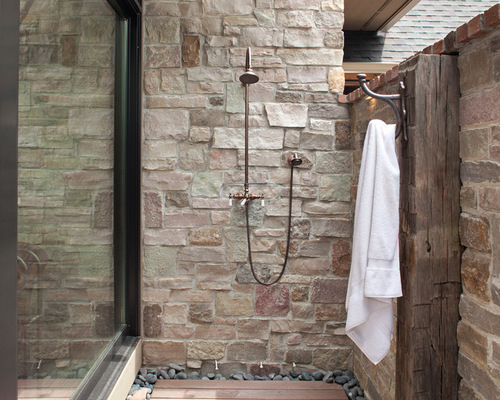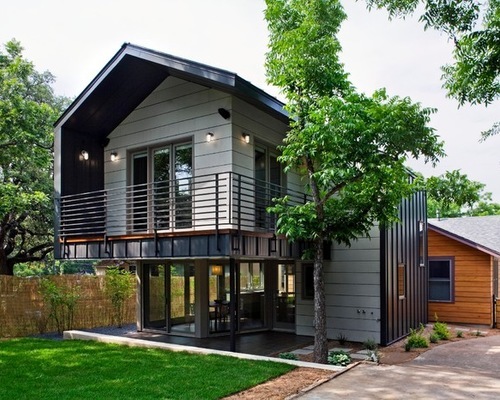Get the Perfect Outdoor Shower for Summer

Showering often feels like more of an obligation than a pleasure — especially if you exercise and have to take more than one a day. Which might explain the burgeoning popularity of outdoor showers. “You’re showering outside in the elements, and there’s something about that that intrigues people,” says Phil Regan, principal designer at Hutker Architects.
Outdoor showers have become so popular, Regan can’t remember a time he did a house without one. (Of course, that might have something to do with the fact that his office is in Martha’s Vineyard, an upscale resort island off the coast of Massachusetts.) But even if you’re not a block from the beach (or the nearest neighbor), outdoor showers can shake up your routine and make you feel closer to nature.

Outdoor Shower 1: John Kraemer & Sons, original photo on Houzz
Project: Add an outdoor shower.
Why: An outdoor shower makes a mundane ritual much more appealing, allowing you to savor fresh air, sky, birdsong and possibly even a view while you bathe. It’s especially handy for rinsing off before or after a dip in the pool, a trip to the beach or a grubby day of gardening. Many homeowners use them for bathing their dogs.
Related: Give Wildlife Shelter From the Summer Sun With a Birdhouse
“It’s a pretty sybaritic experience, but not everyone is going to be comfortable with that,” acknowledges architect Julie Campbell of CTA Design Builders in Seattle.

Outdoor Shower 2: brianvandenbrink.com, original photo on Houzz
Who to hire: Outdoor showers require excavation, slab work, plumbing and alterations to the existing walls of the home, so don’t just hire a plumber — go with a general contractor who has experience building outdoor showers. Without that, “you’re probably going to make a bunch of simple mistakes,” says Regan, whose firm designed the shower tower shown here.

Outdoor Shower 3: John Cole Architect, original photo on Houzz
Cost range: A simple shower with hot and cold running water, like this one, can cost less than $1,000 to install. A moderate setup with a fancier enclosure can run anywhere from $1,000 to $4,000. And a more elaborate shower can cost $4,000 to $8,000 or more.
Related: Shower Stalls For a Luxe Experience
Typical project length: A simple installation can be done in two weeks; allow six to eight weeks for more complex projects.

Outdoor Shower 4: Charles Rose Architects Inc, original photo on Houzz
Permit: You’ll probably need a plumbing permit. Whether you’ll need a building permit depends on the design, cost and complexity of the project and the rules in your municipality. Many jurisdictions don’t even allow outdoor showers, so do your homework first.
Best time to do this project: Anytime the ground is not frozen.

Outdoor Shower 5: Hutker Architects, original photo on Houzz
First step: The most important thing to consider when planning an outdoor shower is the location. You want it to be somewhere that gets direct sun, not only because it makes the act of showering more pleasant, but because it’ll keep the shower walls and floor drier — and that’s critical to preventing rot and scum. For that same reason, don’t place the shower under a roof overhang or tree (which could also cause debris to accumulate on the shower floor).
The other big consideration is privacy. Locate the shower away from probing eyes or add an enclosure that assures privacy (but maintains air circulation). If your house is two stories or is flanked by windows that could look down onto the shower, consider a louvered roof that prevents views in but still allows views out.
“If you want to experience the outdoors, you want to find a way to create privacy that doesn’t take away from that experience you’re looking for,” says Campbell.

Outdoor Shower 6: CTA Design Builders Inc, original photo on Houzz
Considerations: If the shower abuts your exterior, that siding will get pelted with more water than it was designed to withstand, so go with a material like cedar, mahogany or teak and add a waterproof membrane underneath to guard against water infiltration. To avoid siding problems, locate the shower away from the house.
If you live in a climate that gets cold, be sure to locate the water shutoff valve inside the house, and have the pipes blown out at the end of the season to avoid any water freezing in the pipes.
The shower needs to drain into either the home’s gray water system or a French drain, consisting of a large pit filled with several feet of gravel that filters the water as it returns to the soil. (Expect to replace the gravel every five or six years.) Needless to say, you want to direct the drainage away from the foundation and basement, and if you plan to use soap in the shower, away from plants as well.
If possible, situate the shower to take advantage of the site’s attributes, such as views or rock outcrops. “If there are natural amenities as part of the site, that’s all the more fun you can have with it,” says Regan.
10 Home Projects That Need a Pro

If you are working on a DIY remodel, deciding whether to call in a specialty contractor to perform a specific task comes down to several areas you’ll need to consider:
Skill. Do you have the necessary skills to build a sound structure, and do it safely?
Scale. Is the size of the project one that you can handle in a reasonable amount of time?
Cost. When factoring in the value of your own time, can the project be completed for less cost by a professional? Do you have the tools you need?
Aesthetics. Can you finish the project attractively enough that you’re not sacrificing resale value? Would a rough grout joint or wallpaper seam bother you?
Learn more about the specific problem areas that often require professional help below.

Contractor 1: Weber + Studio Architects, original photo on Houzz
1. Structural elements. Beams, footers, headers etc. — these are the unglamorous and often hidden parts of a home that are critical to its long-term stability and safety. Don’t take chances with structural components. Everything should be drawn or approved by an engineer, whose specifications should be followed to the letter.

Contractor 2: Re:Vision Architecture, original photo on Houzz
2. Electrical. Here’s another one where safety and skill intersect. Poor wiring can be a safety hazard — just because you were able to wire something up and it worked, doesn’t mean you haven’t created a safety hazard. If you aren’t confident you have the knowledge to perform the needed work and assess the implications of your work on the rest of the circuit and panel, call in a professional.

Contractor 3: Jeffrey Dungan Architects, original photo on Houzz
3. Roofing. Here’s a good example of a project where even if you feel you have the skills to perform the task safely and properly, you may not be able to complete the project in a short enough period of time to avoid exposing your home to damage from rain. If you can’t get your roofing project done in a couple days, don’t start it. Even professionals can underestimate the time a project will take to complete, so you may want to double your estimate.
Related: Siding Contractors to Get the Job Done
4. Plumbing. A clogged drain line and a faucet that needs to be replaced are tasks that you know you can complete. Before you do either yourself, though, think about the true cost.
What is your time worth? Do you have the tools? If you end up renting a drain snake from the home center that doesn’t work when you get it home, and you need to make another trip before you even clear the drain, you may lose much of a precious Saturday.

Contractor 4: Buckminster Green LLC, original photo on Houzz
5. Insulation. Certain types of insulation, such as spray foam, should be left to the professionals. Many people assume that installing batt insulation like fiberglass is an easy project, but there is a lot of room for error here. If you leave gaps you can create spots that draw heat and moisture into your walls — a bad combination. Even if you do the job well, it’s messy work. Plus, insulation contractors get a much better deal on the material costs than you would, offsetting the labor savings of a DIY project.
6. Carpentry. Even if you have the skills to complete the project, professional carpenters will have the tools and experience to get the job done quickly. If you are trying to complete the project on a part-time basis, remember to factor in setup and cleanup time. Working a full day is often much more efficient than an hour here and there.

Contractor 5: Ike Kligerman Barkley, original photo on Houzz
7. Masonry. This is one that bridges all four factors — if there is a structural component to the masonry project (and there usually is), safety is a concern. The scale of projects involving stone, brick and concrete can be deceiving. Make sure you know what you’re getting into. Wrestling a heavy stone into place and making it look good takes years to master. When you factor in all of this, the cost of paying for good work can be a bargain.
8. Wallpaper. There isn’t much room for error here. You have to get it right the first time. You’re drawing attention to the wall by dressing it up, so it had better look good. You wouldn’t pay an arm and a leg for a beautiful fabric and then make a sloppy-looking dress, so don’t buy a gorgeous paper and put it up with misaligned seams and bad corners.

Contractor 6: Buckminster Green LLC, original photo on Houzz
9. Tile. The pace of tile installation is slower than that of wallpaper, and there is a lot of contemplation that goes into a good tile installation. If you aren’t experienced, you may discover something you should have thought about when it’s too late. You also want to prep correctly. Tiles are all different and require different approaches to installation. Your DIY tile floor may look good when it’s done, but can you be sure it will hold up and not crack in a year or two? If you are confident about that, go for it. If not, call a professional.
10. Painting. I know, it sounds ridiculous — if you can’t paint, what DIY project can you do? Keep in mind, I’m not here to stop you from painting your own house. Just consider that a good, lasting paint job takes a lot of prep work. Sometimes this can involve wall repair, scraping paint (which can be a health risk if it’s lead paint), priming and caulking over old finishes with various products. Depending on what you’re working with, you may need someone with more experience to help.
By Kenny Grono, Houzz
 Facebook
Facebook
 X
X
 Pinterest
Pinterest
 Copy Link
Copy Link